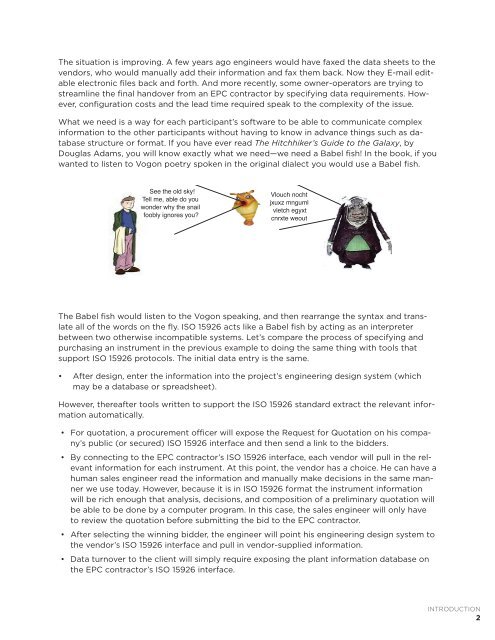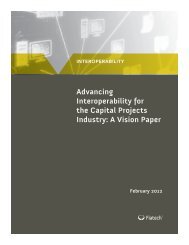An Introduction to ISO 15926 November 2011 - iRINGToday
An Introduction to ISO 15926 November 2011 - iRINGToday
An Introduction to ISO 15926 November 2011 - iRINGToday
Create successful ePaper yourself
Turn your PDF publications into a flip-book with our unique Google optimized e-Paper software.
The situation is improving. A few years ago engineers would have faxed the data sheets <strong>to</strong> the<br />
vendors, who would manually add their information and fax them back. Now they E-mail editable<br />
electronic files back and forth. <strong>An</strong>d more recently, some owner-opera<strong>to</strong>rs are trying <strong>to</strong><br />
streamline the final handover from an EPC contrac<strong>to</strong>r by specifying data requirements. However,<br />
configuration costs and the lead time required speak <strong>to</strong> the complexity of the issue.<br />
What we need is a way for each participant’s software <strong>to</strong> be able <strong>to</strong> communicate complex<br />
information <strong>to</strong> the other participants without having <strong>to</strong> know in advance things such as database<br />
structure or format. If you have ever read The Hitchhiker’s Guide <strong>to</strong> the Galaxy, by<br />
Douglas Adams, you will know exactly what we need—we need a Babel fish! In the book, if you<br />
wanted <strong>to</strong> listen <strong>to</strong> Vogon poetry spoken in the original dialect you would use a Babel fish.<br />
The Babel fish would listen <strong>to</strong> the Vogon speaking, and then rearrange the syntax and translate<br />
all of the words on the fly. <strong>ISO</strong> <strong>15926</strong> acts like a Babel fish by acting as an interpreter<br />
between two otherwise incompatible systems. Let’s compare the process of specifying and<br />
purchasing an instrument in the previous example <strong>to</strong> doing the same thing with <strong>to</strong>ols that<br />
support <strong>ISO</strong> <strong>15926</strong> pro<strong>to</strong>cols. The initial data entry is the same.<br />
• After design, enter the information in<strong>to</strong> the project’s engineering design system (which<br />
may be a database or spreadsheet).<br />
However, thereafter <strong>to</strong>ols written <strong>to</strong> support the <strong>ISO</strong> <strong>15926</strong> standard extract the relevant information<br />
au<strong>to</strong>matically.<br />
• For quotation, a procurement officer will expose the Request for Quotation on his company’s<br />
public (or secured) <strong>ISO</strong> <strong>15926</strong> interface and then send a link <strong>to</strong> the bidders.<br />
• By connecting <strong>to</strong> the EPC contrac<strong>to</strong>r’s <strong>ISO</strong> <strong>15926</strong> interface, each vendor will pull in the relevant<br />
information for each instrument. At this point, the vendor has a choice. He can have a<br />
human sales engineer read the information and manually make decisions in the same manner<br />
we use <strong>to</strong>day. However, because it is in <strong>ISO</strong> <strong>15926</strong> format the instrument information<br />
will be rich enough that analysis, decisions, and composition of a preliminary quotation will<br />
be able <strong>to</strong> be done by a computer program. In this case, the sales engineer will only have<br />
<strong>to</strong> review the quotation before submitting the bid <strong>to</strong> the EPC contrac<strong>to</strong>r.<br />
• After selecting the winning bidder, the engineer will point his engineering design system <strong>to</strong><br />
the vendor’s <strong>ISO</strong> <strong>15926</strong> interface and pull in vendor-supplied information.<br />
• Data turnover <strong>to</strong> the client will simply require exposing the plant information database on<br />
the EPC contrac<strong>to</strong>r’s <strong>ISO</strong> <strong>15926</strong> interface.<br />
INTRODUCTION<br />
2



